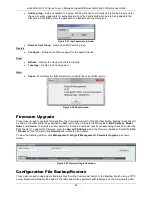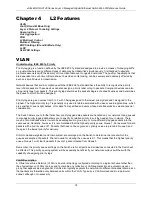
xStack® DGS-3120 Series Layer 3 Managed Gigabit Ethernet Switch Web UI Reference Guide
59
resides),
MAC Address
,
Model Name
and
Firmware Version
. To update the configuration file, enter the
Server
IP Address
where the file resides and enter the
Path \ Filename
of the configuration file. Click
Restore
to initiate
the file transfer from a TFTP server to the Switch. Click
Backup
to back up the configuration file to a TFTP server.
To view the following window, click
Management > Single IP Management > Configuration File
Backup/Restore
, as shown below:
Figure 3-34 Configuration File Backup/Restore window
Upload Log File
The following window is used to upload log files from SIM member switches to a specified PC. To upload a log file,
enter the
Server IP Addres
s of the SIM member switch and then enter a
Path \ Filename
on your PC where you
wish to save this file. Click
Upload
to initiate the file transfer.
To view the following window, click
Management > Single IP Management > Upload Log File
, as shown below:
Figure 3-35 Upload Log File window
SNMP Settings
Simple Network Management Protocol (SNMP) is an OSI Layer 7 (Application Layer) designed specifically for
managing and monitoring network devices. SNMP enables network management stations to read and modify the
settings of gateways, routers, switches, and other network devices. Use SNMP to configure system features for
proper operation, monitor performance and detect potential problems in the Switch, switch group or network.
Managed devices that support SNMP include software (referred to as an agent), which runs locally on the device. A
defined set of variables (managed objects) is maintained by the SNMP agent and used to manage the device.
These objects are defined in a Management Information Base (MIB), which provides a standard presentation of the
information controlled by the on-board SNMP agent. SNMP defines both the format of the MIB specifications and
the protocol used to access this information over the network.
The Switch supports the SNMP versions 1, 2c, and 3. The three versions of SNMP vary in the level of security
provided between the management station and the network device.
In SNMPv1 and SNMPv2c, user authentication is accomplished using ‘community strings’, which function like
passwords. The remote user SNMP application and the Switch SNMP must use the same community string. SNMP
packets from any station that has not been authenticated are ignored (dropped).
The default community strings for the Switch used for SNMPv1 and SNMPv2c management access are:
•
public
– Allows authorized management stations to retrieve MIB objects.
•
private
– Allows authorized management stations to retrieve and modify MIB objects.
Summary of Contents for xStack DGS-3120 Series
Page 1: ......
















































